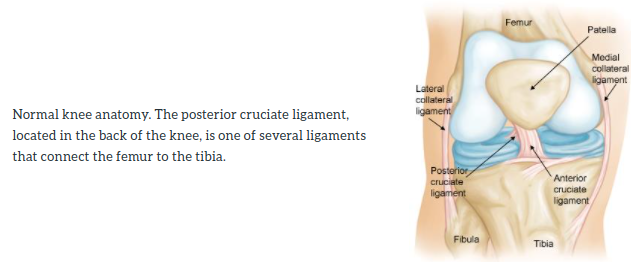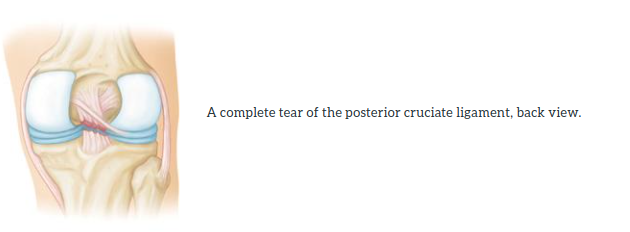Posterior Cruciate Ligament (PCL) Injuries
The posterior cruciate ligament (PCL) is located inside the knee, just behind the anterior cruciate ligament (ACL). It is one of several ligaments that connect the femur (thighbone) to the tibia (shinbone). The posterior cruciate ligament keeps the tibia from moving backward with relation to the thigh bone.
An injury to the posterior cruciate ligament requires a powerful force. A common cause of injury is a bent knee hitting a dashboard in a car accident or a football player falling on a knee that is bent. Additionally, damage to the PCL can result from a severe twisting injury or contact injury during sport
Anatomy
Three bones meet to form your knee joint: the femur (thighbone), the tibia (shinbone), and the patella (kneecap). The kneecap sits in front of the joint to provide some protection.
Bones are connected to other bones by ligaments. There are four primary ligaments in your knee. They act like strong ropes to hold the bones together and keep your knee stable.
Collateral ligaments. These are found on the sides of your knee. The medial collateral ligament is on the inside, and the lateral collateral ligament is on the outside. They control the side to side motion of your knee and brace it against unusual movement.
Cruciate ligaments. These are found inside your knee joint. They cross each other to form an X (or cross), with the anterior cruciate ligament in front and the posterior cruciate ligament in back. The cruciate ligaments control the front and back motion of your knee.

The posterior cruciate ligament keeps the shinbone from moving backward too far. It is stronger than the anterior cruciate ligament and is injured far less often. The posterior cruciate ligament has two parts, which blend into one structure about the size of a person's little finger.
Description
Injuries to the posterior cruciate ligament are not as common as other knee ligament injuries. In fact, they are often subtle and more difficult to evaluate than other ligament injuries in the knee.
Injuries to the posterior cruciate ligament are not as common as other knee ligament injuries. In fact, they are often subtle and more difficult to evaluate than other ligament injuries in the knee.
Often, a posterior cruciate ligament injury occurs along with injuries to other structures in the knee, such as cartilage, other ligaments, and bone.

Many posterior cruciate ligament tears are partial tears with the potential to heal on their own. People who have injured only their posterior cruciate ligaments may be able to return to sports without experiencing knee stability problems.
Cause
An injury to the posterior cruciate ligament can happen many ways. It typically requires a powerful force.
- A direct blow to the front of the knee (such as a bent knee hitting a dashboard in a car crash, or a fall onto a bent knee in sports)
- Pulling or stretching the ligament (such as in a twisting or hyperextension injury)
PCL injuries are rarely caused by a simple misstep.
Symptoms
The typical symptoms of a posterior cruciate ligament injury are:
- Pain with swelling that occurs steadily and quickly after the injury
- Swelling that makes the knee stiff and may cause a limp
- Difficulty walking
- The knee feels unstable, like it may give out
Doctor Examination
During your first visit, your doctor will talk to you about your symptoms and medical history.
Physical examination
During the physical examination, your doctor will check all the structures of your injured knee, and compare them to your non-injured knee. Your injured knee may appear to sag backwards when bent. It might slide backwards too far, particularly when it is bent beyond a 90-degree angle.
Imaging tests
Other tests that may help your doctor confirm your diagnosis include X-rays and magnetic resonance imaging (MRI) scans. It is possible, however, for these images to appear normal, especially if the injury occurred more than 3 months before the tests.
X-rays. Although they will not show any injury to your posterior cruciate ligament, X-rays can show whether the ligament tore off a piece of bone when it was injured. This is called an avulsion fracture. Your doctor may also order stress views, in which the doctor can assess just how far back the shin bone can move.
Magnetic resonance imaging (MRI). MRI scans create better images of soft tissues, like the posterior cruciate ligament, than X-rays.
Treatment
Nonsurgical Treatment
If you have injured only your posterior cruciate ligament, your injury may heal quite well without surgery. Your doctor may recommend nonsurgical treatment options:
RICE. When you are first injured, the RICE method — rest, ice, gentle compression, and elevation — can help speed your recovery.
Immobilization. Your doctor may recommend a special brace to prevent the tibia bone from sagging backward (gravity tends to pull the bone backward when you are lying down). To further protect your knee, you may be given crutches to keep you from putting weight on your leg.
Physical therapy. As the swelling goes down, you will start a careful rehabilitation program. Specific exercises will restore function to your knee and strengthen the leg muscles that support it. Strengthening the muscles in the front of your thigh (quadriceps) has been shown to be a key factor in a successful recovery.
Surgical Treatment
Your doctor may recommend surgery if you have combined injuries. For example, if you have dislocated your knee and torn multiple ligaments including the posterior cruciate ligament, surgery is almost always necessary. Additionally, patients with an isolated PCL tear may benefit from reconstruction if they have persistent instability or pain that is not improving with non-operative treatment.
Rebuilding the ligament. Because sewing the ligament ends back together does not usually heal, a torn posterior cruciate ligament is typically reconstructed, or rebuilt. Your doctor will replace your torn ligament with a tissue graft. This graft is most often taken from another part of your body, or from another human donor (cadaver). It can take several months for the graft to heal into your bone.
Surgery to rebuild a posterior cruciate ligament is typically performed with an arthroscope using small incisions; however, some surgeons will still make an additional incision on the side of the knee. Arthroscopic surgery is less invasive than traditional open surgery. The benefits of less invasive techniques include less pain from surgery and quicker recovery times.
Surgical procedures to repair posterior cruciate ligaments continue to improve. More advanced techniques help patients resume a wider range of activities after rehabilitation.
Rehabilitation
Whether or not your treatment involves surgery, rehabilitation plays a vital role in getting you back to your daily activities. A physical therapy program will help you regain knee strength and motion. If you had surgery, physical therapy will begin 1 to 4 weeks after your procedure.
How long it takes you to recover from a posterior cruciate ligament injury will depend on the severity of your injury. Combined injuries often have a slow recovery, but most patients do well over time.
If your injury requires surgery, it may be several weeks before you return to a desk job — and possibly months if your job requires a lot of activity. Full recovery typically requires 6 to 12 months.
Although rehabilittion is a slow process, your commitment to therapy is the most important factor in eventually returning to all the activities you enjoy.











